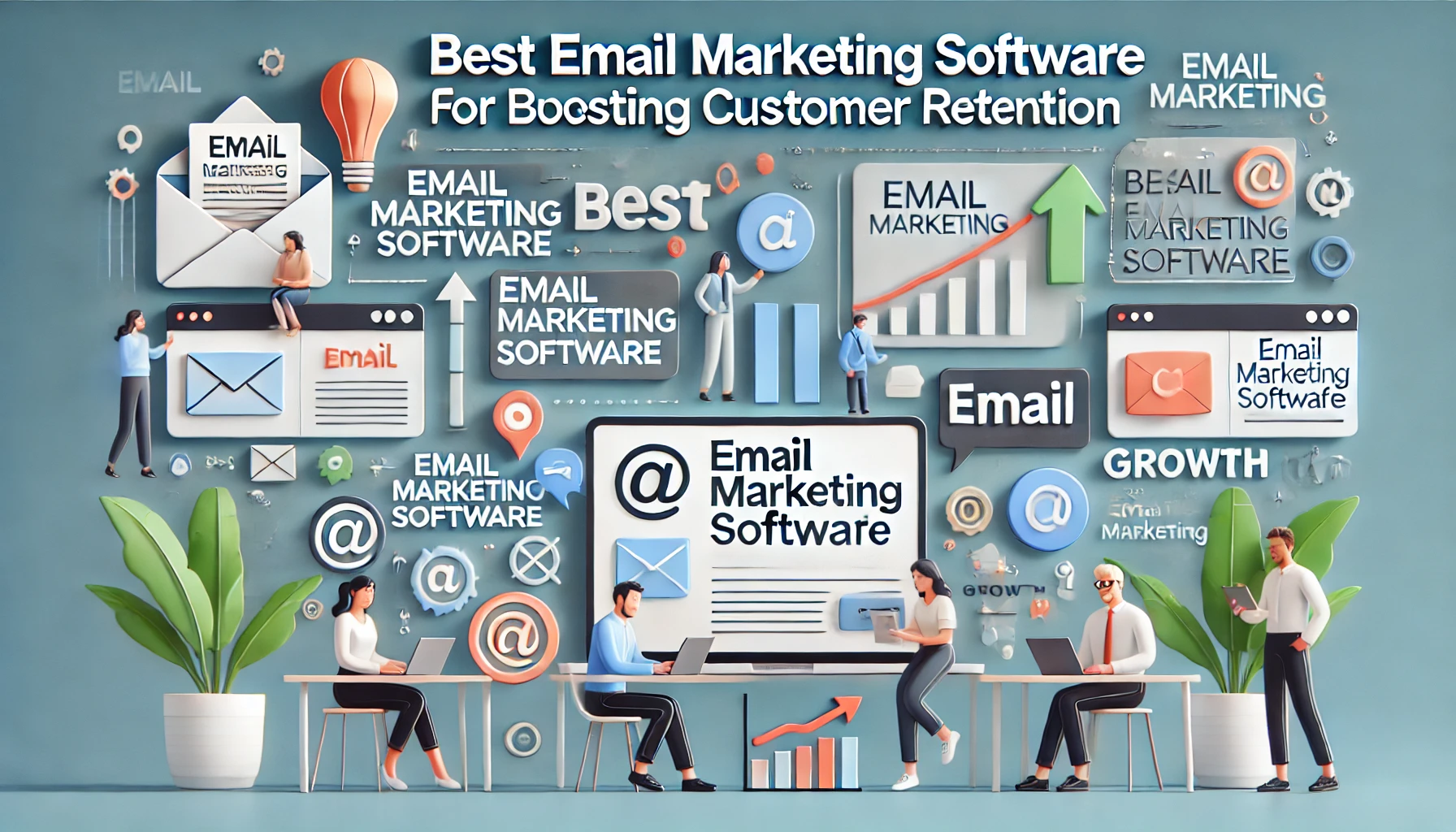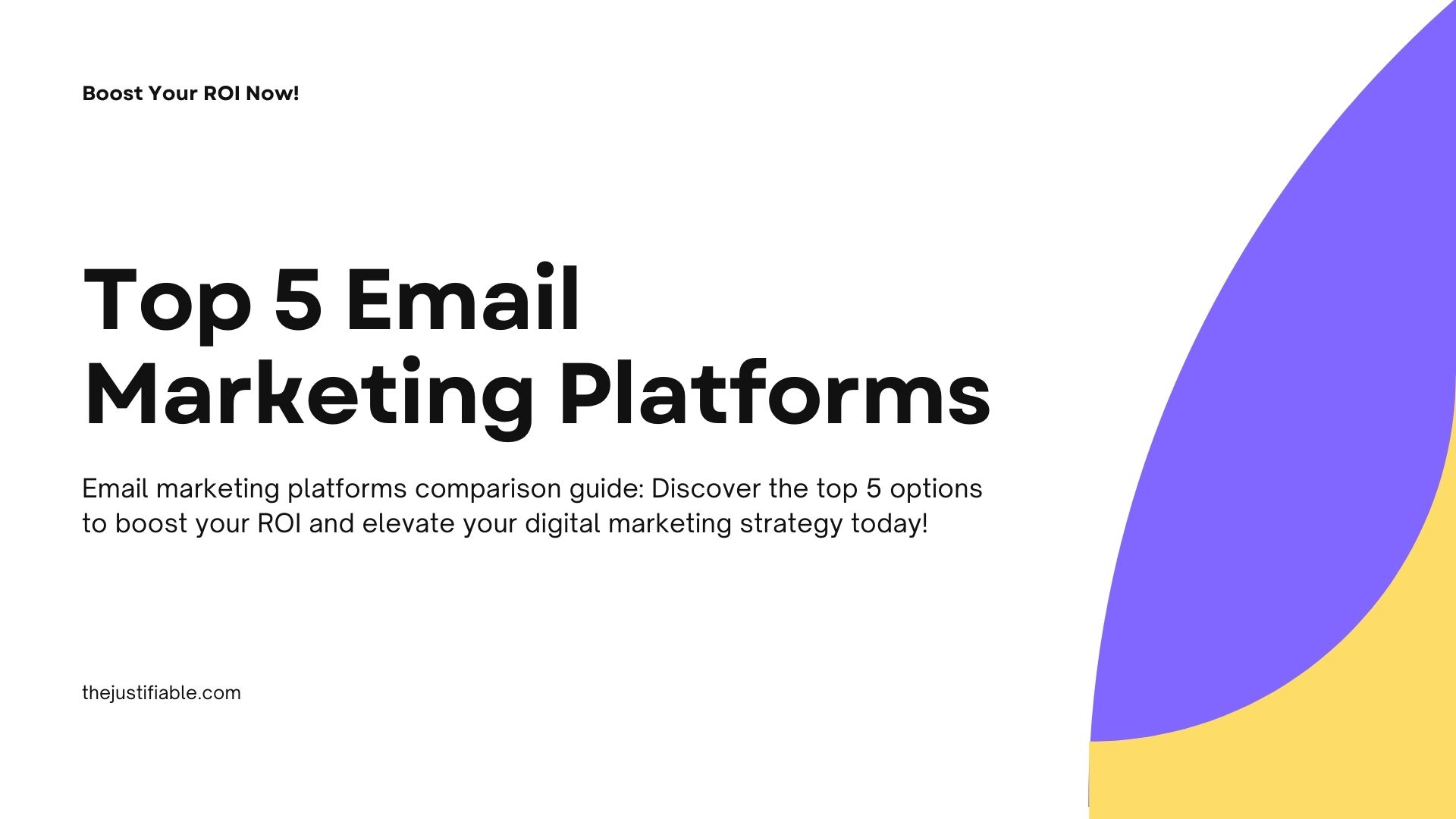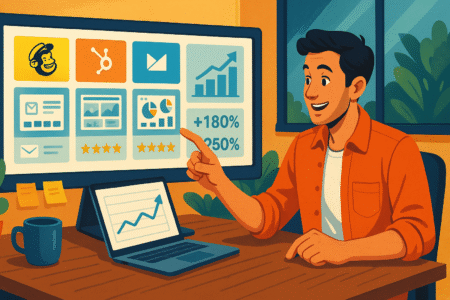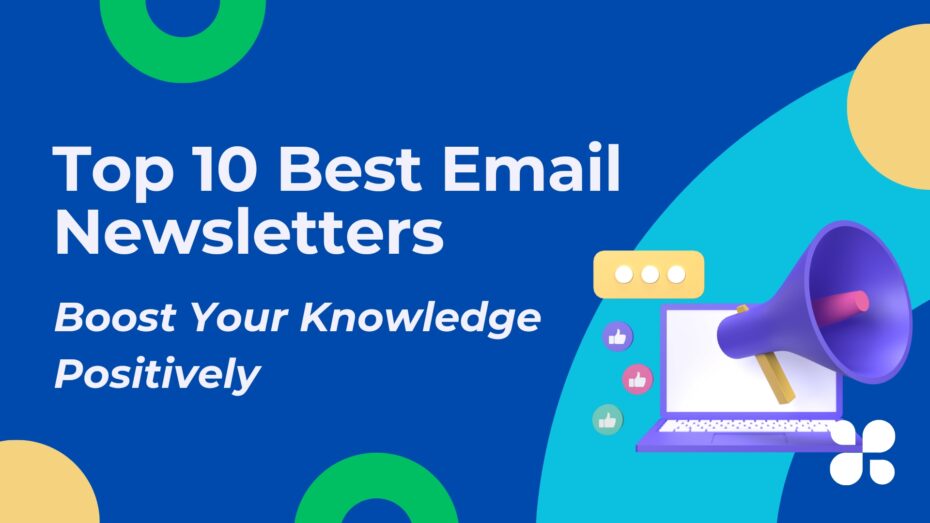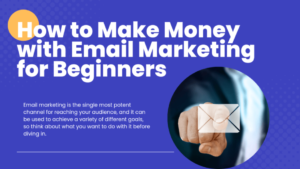Table of Contents
Are you looking for the best email marketing software to enhance your customer retention strategy? How can email marketing tools help you build stronger customer relationships and drive repeat business?
In this article, we’ll explore the top software solutions that will help you automate, personalize, and optimize your email campaigns for maximum retention success.
Why Email Marketing Is Crucial For Customer Retention Success
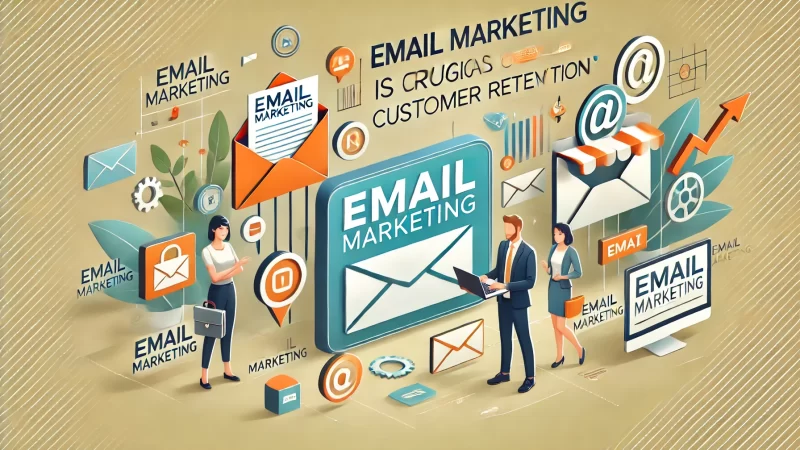
Email marketing plays a significant role in maintaining and strengthening relationships with your existing customers. By delivering relevant content directly to their inbox, businesses can keep their audience engaged, foster loyalty, and drive repeat purchases, which ultimately boosts long-term success.
Understanding The Role Of Retention In Business Growth
Customer retention is vital for any business because it’s more cost-effective to retain customers than to acquire new ones. I believe that nurturing existing relationships leads to steady, predictable revenue streams, allowing businesses to scale sustainably. With the right strategy, email marketing can play a crucial role in keeping customers returning.
A high customer retention rate positively impacts brand loyalty, helping you build a community of satisfied customers. When you keep customers happy through thoughtful email campaigns, they’re more likely to recommend your products or services to others. This organic growth can be a game-changer.
I’ve seen how focused retention strategies can decrease customer churn. For example, offering exclusive deals via email is a proven way to keep your audience engaged. A little extra attention, like a personalized email, can make all the difference.
Retention is the key to maximizing lifetime customer value. Businesses that effectively use email marketing to communicate with their customers see higher repeat purchases, resulting in more predictable revenue and sustained growth over time.
The Benefits Of Automating Your Email Campaigns
Automation saves time and ensures that your emails reach customers at the perfect moment. With automated workflows, you can send timely messages, like welcome emails or follow-ups, without manual effort. I suggest using automation to streamline your processes and boost efficiency.
Automating your emails also leads to higher engagement rates. Automated campaigns, such as cart abandonment reminders, have a better chance of converting since they’re triggered by user actions. In my experience, these targeted messages help re-engage potential customers at critical moments.
I recommend automation because it allows you to segment your audience more effectively. You can send tailored content to different customer groups, ensuring each message is relevant. This leads to stronger customer relationships, as recipients feel that the emails are personalized just for them.
Automated campaigns also provide valuable insights. You can track open rates, click-throughs, and conversions in real time, helping you fine-tune your strategy. This data-driven approach will improve your retention efforts and help you get the most out of your email marketing.
How Consistent Communication Drives Customer Loyalty
Consistent communication keeps your brand top-of-mind, which is essential for building loyalty. Regular emails remind your customers of your value, and I’ve found that well-timed messages can make a real impact. This consistency reinforces trust and strengthens your customer relationships.
Sending regular updates, promotions, or helpful content ensures that your customers don’t forget about you. I advise focusing on delivering value in every email to maintain a strong connection with your audience. Over time, this will drive long-term loyalty and customer retention.
Loyal customers are more likely to engage with your brand. By maintaining consistent contact, you build a deeper relationship with your audience, which makes them feel valued. This can result in more frequent purchases and a stronger connection to your business.
Consistent communication also provides a platform for receiving feedback. Encourage customers to reply to your emails or participate in surveys. This two-way communication fosters trust and gives you valuable insights into how to better serve your customers.
Why Personalization Boosts Engagement And Retention Rates
Personalization is the key to creating meaningful connections with your customers. I believe that when you personalize emails, you show your customers that you understand their needs. This creates a more relevant and engaging experience, leading to higher retention rates.
Emails that are tailored to individual preferences or past behaviors are far more likely to be opened and acted upon. Personalized content can include anything from the recipient’s name to product recommendations based on previous purchases. This kind of thoughtful approach deepens customer loyalty.
I’ve seen how personalized subject lines and content can significantly boost email open rates. When customers see a message that resonates with them, they’re more likely to engage with it. This engagement fosters a stronger relationship, which translates to better retention.
Segmentation plays a big role in personalization. By dividing your customer base into smaller, more targeted groups, you can send more relevant content. This strategy helps customers feel understood and appreciated, which strengthens their connection to your brand.
Top Features To Look For In The Best Email Marketing Tools
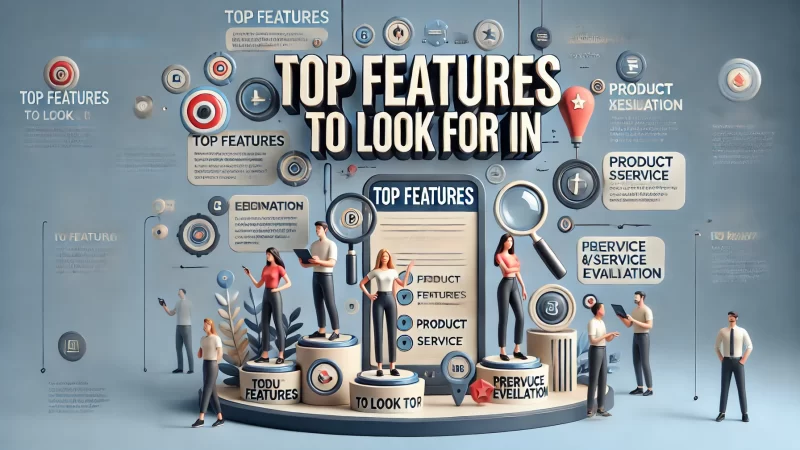
When choosing the best email marketing software, it’s important to focus on key features that will help you manage campaigns efficiently and achieve the best results. I suggest looking for tools that streamline your process and offer powerful automation, segmentation, and analytics capabilities.
Automation Capabilities For Seamless Campaign Management
Effective automation allows you to set up workflows that run in the background, ensuring your emails reach the right people at the right time. I suggest choosing email marketing software that offers customizable automation options, as this will save you time and boost efficiency.
Automation also enables you to create complex campaigns without manual effort. For instance, you can automate welcome series, drip campaigns, or re-engagement emails. These features ensure your messages are timely and relevant, keeping your audience engaged over time.
Another benefit of automation is the ability to trigger emails based on customer actions. For example, if someone abandons their shopping cart, an automated email reminder can encourage them to complete their purchase. These automated nudges are highly effective for improving conversion rates.
I advise integrating your email marketing tool with other platforms, like your CRM, to fully utilize automation. This integration allows for more seamless data sharing, helping you craft more personalized and effective email campaigns.
Advanced Segmentation For Targeted Messaging
Segmentation lets you send targeted messages to specific groups within your email list. By dividing your audience into smaller segments based on behaviors or preferences, you can send more relevant content. I recommend using segmentation to improve the relevance of your emails and, in turn, customer retention.
With advanced segmentation, you can create highly personalized campaigns. For example, you could send one message to repeat customers and a different one to those who have never made a purchase. This strategy ensures that each email speaks directly to the recipient’s needs.
I suggest using segmentation to track how different groups respond to your campaigns. You can then tweak your messages to better serve each segment, increasing engagement and retention. Tailoring content to specific audiences ensures that your emails resonate more effectively.
Segmentation also helps you identify which segments are most valuable to your business. By focusing on high-value customers and tailoring campaigns to their needs, you can boost loyalty and encourage repeat business, which is essential for long-term success.
Personalization Features To Improve Customer Experience
Personalization features allow you to tailor your emails to each recipient’s preferences. I believe that when you use personalized subject lines, greetings, and content, you show your customers that you value them as individuals. This personal touch can significantly improve customer experience and retention.
Personalized product recommendations are a great example of how to enhance customer experience. By suggesting products based on past purchases or browsing history, you can create a more tailored shopping experience, which leads to higher engagement and retention rates.
Personalization also extends to timing. I suggest sending emails based on your customers’ behavior, such as follow-ups after a purchase or recommendations after browsing. This level of customization helps keep your brand relevant in your customers’ minds, improving long-term loyalty.
In my experience, customers respond best when emails feel personal and relevant. Using personalization features strategically throughout your email marketing campaigns will not only improve customer experience but also boost retention rates over time.
Analytics And Reporting To Optimize Performance
Analytics are essential for understanding how well your email campaigns are performing. I suggest using email marketing tools that offer in-depth reporting, allowing you to track open rates, click-through rates, and conversion rates. These insights will help you fine-tune your strategy for better results.
You can also use analytics to identify areas where your campaigns may be falling short. For instance, if your open rates are low, you can experiment with different subject lines or send times. Data-driven adjustments can lead to improved performance and higher retention rates.
In my opinion, analytics help you understand your customers better. By tracking engagement metrics, you can see which content resonates most with your audience. This allows you to create more targeted campaigns that keep customers interested and loyal to your brand.
Finally, reporting tools enable you to measure the ROI of your email marketing efforts. I suggest tracking revenue generated from email campaigns to see how they contribute to your overall business goals. This will help you justify your email marketing investment and refine your strategy moving forward.
How To Choose The Best Email Marketing Software For Your Business
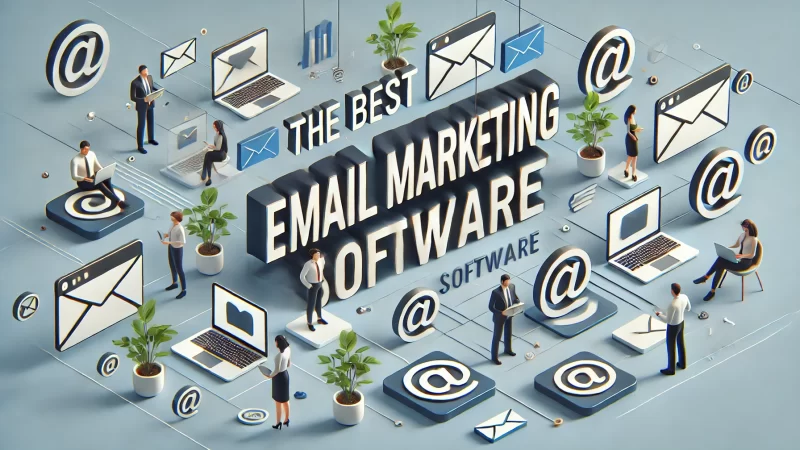
Choosing the best email marketing software for your business requires careful consideration of your specific needs and goals. I suggest focusing on factors like your budget, scalability, integration capabilities, and ease of use to ensure the software supports long-term growth.
Assessing Your Business Needs And Budget
First, identify what you need from the software. I recommend thinking about the size of your audience, the type of emails you plan to send, and how much automation you require. This will help you narrow down the options based on functionality.
Budget is a key consideration. There are free tools that offer basic features, but I believe investing in a premium tool can pay off in the long run. With more advanced options, you get access to features like advanced analytics and A/B testing.
Evaluate how email marketing fits into your overall business strategy. If you’re planning to grow quickly, choosing software that scales with you is important. I advise looking for platforms with pricing tiers that align with your business growth stages.
You should also account for hidden costs. Some tools charge extra for additional subscribers or advanced features. I suggest reading the fine print to avoid surprises and ensure the tool fits your financial plan.
Evaluating Scalability And Integration Options
Scalability is critical if your business is growing. I recommend choosing software that can handle increasing subscribers and complex campaigns as your needs evolve. This way, you won’t need to switch platforms later, which could be costly and disruptive.
Integration with other tools is another important factor. Your email marketing software should sync with your CRM, e-commerce platform, and social media tools. This creates a seamless flow of data, helping you manage all aspects of your marketing from one place.
I believe that choosing software that integrates well with your existing tech stack saves time and enhances efficiency. When everything works together, you can automate more tasks and ensure that your emails are sent to the right people at the right time.
I suggest considering how well the software supports future integrations. If you plan to add more marketing tools down the line, ensure that your email platform can adapt and integrate easily. This future-proofs your choice, making it a long-term investment.
The Importance Of A User-Friendly Interface
An intuitive, easy-to-use interface is essential for managing your campaigns efficiently. I recommend testing the software’s interface before committing, as it should allow you to design and send emails without hassle, even if you’re not tech-savvy.
A clean and simple dashboard saves time and reduces the learning curve. If your team struggles with the interface, they’re likely to make mistakes or avoid using it altogether. I’ve found that tools with drag-and-drop editors are especially helpful for beginners.
Your email marketing software should streamline the entire process, from designing emails to tracking results. If the platform is difficult to navigate, it can slow you down. I suggest choosing one that offers straightforward tools without unnecessary complexity.
A user-friendly interface also means better team collaboration. If multiple people are working on campaigns, they need to easily access and share information. I recommend looking for tools that offer clear navigation and user roles to keep everything organized.
Customer Support And Resources For Ongoing Success
Strong customer support is a must when using any software. I advise choosing an email marketing platform with a reliable support team, whether through live chat, phone, or email. You’ll want quick help if something goes wrong during an important campaign.
Resources like tutorials and webinars can make a big difference in your team’s ability to use the software effectively. I suggest looking for a platform that provides detailed guides and training materials to help you get the most out of your investment.
Community forums and user groups are also valuable for troubleshooting and sharing best practices. I recommend joining these communities to stay up-to-date with new features and strategies that can enhance your email marketing efforts.
Lastly, I believe that responsive and helpful customer support can save you time and reduce frustration. Before committing, check out the reviews of the platform’s support to ensure they can assist you whenever needed.
Best Email Marketing Software For Small To Medium-Sized Businesses
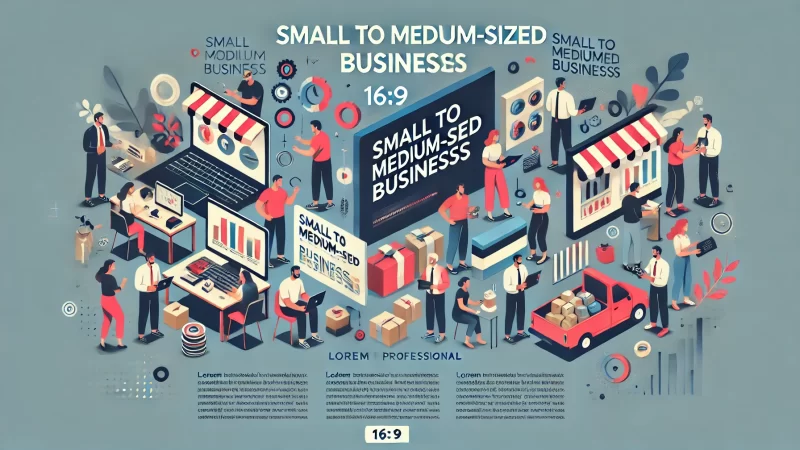
Small to medium-sized businesses (SMBs) need email marketing tools that offer a balance of affordability and powerful features. I suggest looking for software that can grow with your business, offering useful integrations, simple interfaces, and scalable pricing.
Affordable Solutions With Powerful Features
For SMBs, cost is often a major concern. I suggest looking for affordable email marketing tools that still offer robust features. There are several budget-friendly options that provide automation, segmentation, and personalization, without breaking the bank.
You don’t need to compromise on quality when choosing an affordable platform. I recommend exploring tools like Mailchimp or Brevo, which offer tiered pricing models based on your needs. This flexibility allows you to scale your marketing efforts without overspending.
Free versions of some email platforms can provide a solid foundation for your campaigns. I believe that starting with a free plan and upgrading as your business grows is a smart strategy. You’ll get a feel for the platform without a major financial commitment.
It’s important to choose a tool that offers the essential features you need, even at the lower pricing tiers. I advise making a list of must-have features, like automation and analytics, to ensure your chosen platform can deliver the value you need.
Integration With Other Tools For A Seamless Experience
SMBs often rely on several tools to manage their business, so I recommend choosing email marketing software that integrates easily with your other systems. This ensures a smooth flow of data and streamlines your entire marketing process.
Integrating your email marketing platform with your CRM or e-commerce software helps you target customers more effectively. For instance, I’ve seen how syncing Shopify with your email tool can boost sales by sending personalized product recommendations.
I suggest looking for platforms that integrate with popular business tools like WordPress, Salesforce, or WooCommerce. These integrations make it easier to manage customer data and automate email campaigns based on user behavior or sales patterns.
Effective integration also saves time. When your tools are connected, you don’t need to manually transfer data between systems. I’ve found that this automation frees up more time for you to focus on growing your business.
Simple User Interface For Easy Campaign Management
A straightforward interface is crucial for SMBs that may not have dedicated marketing teams. I suggest choosing email marketing software with a simple, intuitive dashboard that lets you design, send, and track campaigns without needing advanced technical skills.
Tools with drag-and-drop email editors are particularly useful for small businesses. I recommend looking for platforms like Constant Contact or Mailerlite, where you can create professional-looking emails quickly, without needing to hire a designer.
Campaign management should be easy and efficient. If you’re spending too much time trying to figure out how to use the software, it’s not the right fit. I believe that user-friendly tools allow you to focus more on strategy and less on execution.
A clean and organized interface also helps you monitor the success of your campaigns more effectively. With clear analytics, I suggest reviewing metrics like open rates and conversions to improve future campaigns and better engage your customers.
Examples Of Best Email Marketing Tools For Small Businesses
For small businesses, I recommend checking out Mailchimp, a popular option known for its ease of use and generous free plan. It’s great for beginners, offering automation, segmentation, and analytics that help you create effective campaigns without much effort.
Brevo is another excellent choice, offering a robust feature set at an affordable price. I suggest this tool for businesses that need SMS marketing alongside email campaigns, making it a versatile solution for multi-channel marketing.
MailerLite is perfect for small businesses that need an easy-to-use platform with drag-and-drop editors. I believe it’s an ideal choice for those who prioritize simplicity without sacrificing powerful features like automation and detailed reporting.
I also recommend Constant Contact for businesses looking for excellent customer support and built-in marketing templates. Its straightforward interface and helpful resources make it a great option for business owners who want to quickly set up and run campaigns.
Best Enterprise Email Marketing Software For Large Businesses
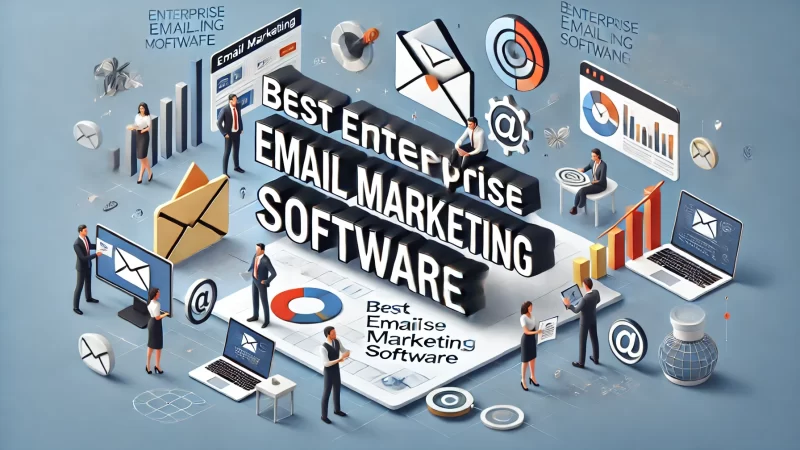
For large businesses, choosing the best email marketing software means finding a platform that can handle complex, high-volume campaigns while offering customization, integration, and scalability. I suggest focusing on tools that provide powerful features and enterprise-level support to maximize performance.
Advanced Features To Support High-Volume Campaigns
Large enterprises often deal with massive contact lists and require software that can handle high-volume email campaigns. I recommend looking for platforms with robust sending infrastructure that ensures emails are delivered efficiently, even when sending millions at once.
Scalability is critical when managing large campaigns. I’ve seen businesses benefit from platforms that offer flexible email quotas and advanced automation. These tools allow you to expand your reach without sacrificing performance or reliability.
High-volume campaigns require more than just large-scale sending capabilities. I suggest focusing on tools that offer dynamic content generation, allowing you to personalize emails at scale. This ensures that even massive campaigns can remain relevant to each recipient.
It’s also important to have advanced scheduling and optimization features. I recommend tools that offer A/B testing and time zone-based delivery, helping you optimize send times and increase engagement, even for global audiences.
Customization And Personalization At Scale
Personalization is key for driving engagement, especially in large campaigns. I believe email marketing tools that offer deep customization and personalization options can help you tailor content to individual recipients, even when sending to thousands of people at once.
Customizing content for different segments within your audience ensures your emails remain relevant. I suggest platforms that allow for behavioral segmentation and dynamic content insertion, helping you create personalized experiences for different customer types.
At scale, personalization can get tricky, but I advise using tools that offer automation with personalization rules. For example, automatically inserting names or product recommendations based on user behavior helps keep emails personal without manual effort.
I recommend platforms that integrate AI-powered personalization tools. These systems can analyze customer data and suggest the best content for each recipient, making large-scale personalization more manageable and improving engagement rates.
Integration With CRM Systems For Better Customer Insights
Seamless integration with CRM systems is vital for large businesses. I believe that syncing email marketing software with your CRM enables better customer insights, allowing you to deliver more targeted and personalized campaigns based on detailed customer profiles.
When your CRM and email marketing tool are connected, you can pull data directly from customer interactions. I suggest platforms that offer real-time syncing, ensuring your campaigns are always based on the latest customer behavior and preferences.
Integration with a CRM also improves automation. I recommend setting up workflows that trigger emails based on customer actions, such as recent purchases or browsing history. This automated approach ensures timely, relevant communication that keeps customers engaged.
Better CRM integration also means better analytics. I advise choosing tools that allow you to track how email campaigns affect customer lifecycle stages. This helps you make data-driven decisions that enhance customer relationships and retention rates.
Examples Of Best Email Marketing Solutions For Large Enterprises
For large enterprises, I recommend considering Salesforce Marketing Cloud. This platform offers advanced automation, deep personalization, and seamless integration with Salesforce CRM, making it an ideal choice for businesses looking to scale their email marketing efforts.
HubSpot is another excellent option, offering a wide range of tools for segmentation, automation, and analytics. I believe HubSpot’s intuitive interface and robust CRM integration make it a great solution for large businesses that need a comprehensive marketing platform.
Marketo, part of the Adobe family, is well-known for its enterprise-level capabilities. I suggest this tool for businesses needing sophisticated automation and reporting, as Marketo excels at handling complex, high-volume campaigns with advanced segmentation features.
Oracle Eloqua is a powerful option for businesses that require advanced data management and integration. I recommend Eloqua for companies that need to integrate email marketing with multiple platforms while handling complex, personalized workflows at scale.
Key Considerations When Switching Email Marketing Software
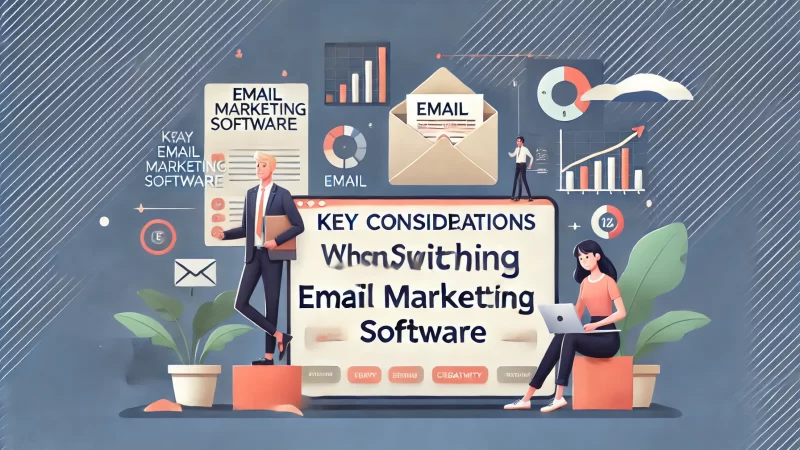
Switching email marketing software can be a complex process, but it’s often necessary to upgrade to a platform that better suits your growing needs. I advise focusing on seamless data migration, minimizing campaign disruptions, and ensuring your team is well-prepared for the transition.
Migrating Your Contact Lists And Data Seamlessly
When switching software, one of the biggest challenges is migrating your contact lists and data without losing valuable information. I suggest ensuring your new platform supports easy imports and exports of all data, from subscriber lists to past campaign performance.
Before migrating, I recommend cleaning your contact list to remove inactive or invalid email addresses. This ensures you only transfer quality data, which can improve deliverability rates on the new platform and prevent issues with bounce rates or spam complaints.
Test the migration process with a small batch of data first. I’ve seen businesses face fewer issues when they perform a trial run before migrating everything. This helps you catch any errors early and avoid disruptions during the full transfer.
I also suggest choosing a new email marketing tool that offers migration support. Many platforms provide assistance during the transfer process, which can help ensure that your data is moved accurately and efficiently, minimizing the risk of data loss.
Avoiding Disruptions To Ongoing Campaigns
One of the main concerns when switching email marketing software is avoiding disruptions to your ongoing campaigns. I recommend planning the switch during a quieter period when you don’t have high-priority campaigns running, to reduce the risk of missed deadlines.
You should also run your old and new platforms in parallel for a short time. This allows you to gradually transition campaigns and ensure that everything is working correctly before fully switching over. I believe this method can help minimize downtime and errors.
Communicate with your team about the transition. Let them know the timeline for switching platforms and any potential impacts. I suggest designating a point person to manage the process and ensure all team members are aware of how to handle any issues that arise.
I recommend testing all campaign automation before going live on the new platform. This includes reactivating workflows and ensuring that all triggers are functioning as intended, preventing any gaps in communication with your audience during the transition.
Training Your Team On The New Software
Training your team on the new software is essential for a smooth transition. I advise taking advantage of any onboarding materials or tutorials offered by the new platform, ensuring that your team feels comfortable and confident using the new system.
Each team member should understand their role in using the new tool. I suggest assigning specific tasks, such as setting up campaigns or analyzing data, to ensure everyone gets hands-on experience with the new software. This hands-on approach speeds up the learning curve.
Consider holding a team-wide training session led by a platform expert. This is especially helpful for complex software. I’ve seen teams become more productive when they receive structured guidance on how to use new tools effectively from day one.
Encourage your team to explore the platform on their own. I believe that giving team members time to test the system and experiment with its features leads to better familiarity and more efficient use in the long run.
How To Measure The Impact Of Switching Tools
After making the switch, it’s important to measure the impact of the new email marketing software. I suggest tracking key performance indicators (KPIs) such as deliverability, open rates, and conversions to determine whether the new platform is meeting your expectations.
Compare the performance of campaigns run on the old platform versus the new one. I recommend reviewing data on engagement, automation efficiency, and personalization success to see where improvements have been made and where further adjustments may be needed.
Monitor your team’s productivity. I’ve found that new software should not only improve campaign performance but also streamline internal processes. Keep an eye on how quickly your team adapts to the new tool and whether it’s helping them work more efficiently.
Finally, gather feedback from your team. I believe regular check-ins can provide valuable insights into any challenges or benefits they’re experiencing with the new platform, allowing you to make further optimizations to ensure a successful transition.
Best Practices For Using Email Marketing To Boost Customer Retention
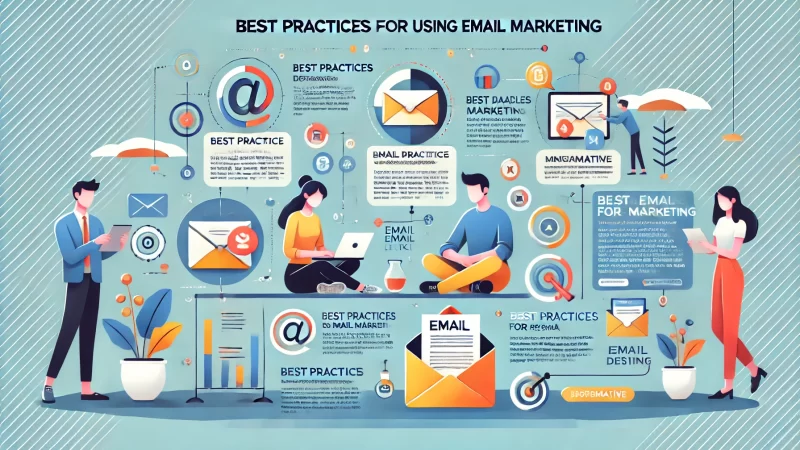
Implementing the best email marketing practices can significantly improve customer retention rates. I believe leveraging automation, personalization, segmentation, and regular campaign analysis can help build lasting relationships with customers and encourage repeat purchases.
Leveraging Automation For Timely, Consistent Messages
Automation ensures your emails are sent at the perfect time, keeping your brand top of mind. I suggest using automated workflows to deliver consistent messages such as welcome emails or post-purchase follow-ups, which strengthen customer relationships over time.
Consistent communication nurtures customer trust. Automated sequences allow you to maintain regular contact without overwhelming your team. I’ve seen how this strategy helps keep customers engaged by ensuring they receive relevant content at key points in their journey.
Triggered emails, like abandoned cart reminders or post-purchase thank-yous, can boost retention. I recommend setting up these automated flows, as they encourage customers to take action without the need for manual intervention, increasing conversions.
Automation also allows you to send time-sensitive offers. I suggest using this feature to create urgency with limited-time promotions or flash sales, which can motivate customers to act and keep them coming back for more.
Personalization Strategies To Improve Customer Experience
Personalized emails show customers that you value their preferences. I believe using data like previous purchases or browsing history to tailor your messages creates a more engaging and relevant experience, which can significantly enhance customer loyalty.
I suggest using personalized subject lines and content to increase open rates and engagement. Small details like addressing the recipient by name or offering product recommendations based on their past behavior can make a big difference in how they respond.
Personalization doesn’t have to be complicated. I recommend segmenting your audience into different groups based on preferences or purchase history and tailoring messages accordingly. This ensures your emails speak directly to each customer’s interests.
Sending birthday or anniversary emails with exclusive offers is a great way to personalize at scale. I’ve seen how these thoughtful touches make customers feel special, improving their experience and boosting retention over time.
Segmentation Tips To Ensure Relevancy
Segmentation allows you to target specific customer groups with relevant content. I recommend dividing your email list based on factors like demographics, purchase behavior, or engagement level to ensure each message resonates with the intended audience.
Targeting high-value customers with exclusive offers can drive repeat business. I suggest creating a segment for loyal customers and sending personalized rewards or VIP access. This not only shows appreciation but also encourages continued loyalty.
I advise segmenting inactive customers to send re-engagement campaigns. By identifying who hasn’t interacted with your emails recently, you can create specific strategies to win them back, such as special discounts or personalized product recommendations.
Frequent shoppers deserve special attention. I recommend segmenting these customers and sending them early access to sales or product launches. This approach rewards their loyalty and keeps them excited about your brand.
Testing And Analyzing Campaigns For Continuous Improvement
Regular testing is essential to improving email performance. I suggest A/B testing different elements of your emails, such as subject lines, call-to-action buttons, or images, to see what resonates best with your audience and optimize future campaigns.
Tracking key metrics like open rates, click-through rates, and conversions provides insights into campaign effectiveness. I believe analyzing this data helps you understand what’s working and where adjustments are needed, ensuring ongoing improvement.
I advise reviewing email engagement regularly to identify trends. Are certain types of content performing better than others? Use these insights to tweak your campaigns and focus on what drives the most engagement and retention.
Always test send times. I’ve found that small adjustments in when you send your emails can significantly impact open rates. Experiment with different days and times to find the optimal schedule that gets the most attention from your audience.
Future Trends In Email Marketing To Improve Customer Retention
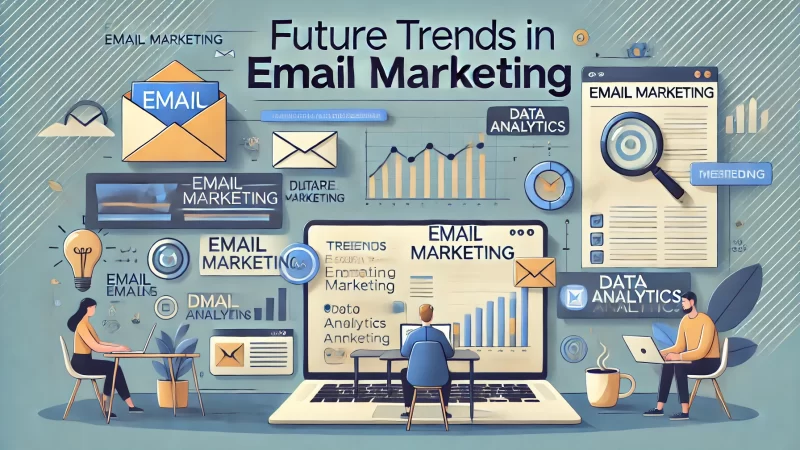
Email marketing is rapidly evolving, and businesses that stay ahead of the curve can significantly improve customer retention. I believe trends like AI-powered personalization, predictive analytics, and automation will play key roles in shaping the future of email marketing.
AI-Powered Personalization For Smarter Campaigns
AI-powered personalization is revolutionizing email marketing. I suggest using AI tools that analyze customer behavior to create tailored content for each recipient. This approach allows you to deliver more relevant messages, increasing engagement and customer retention.
AI can predict what products a customer is most likely to buy. I’ve seen how this helps businesses send highly personalized product recommendations that resonate with customers, resulting in higher open and conversion rates while keeping them engaged with the brand.
AI also optimizes email send times. I recommend using AI to track when individual customers are most active and schedule emails accordingly. This improves open rates and ensures your emails land in their inbox when they’re most likely to engage.
AI simplifies A/B testing by automatically analyzing results and suggesting improvements. I believe this saves time and helps marketers make data-driven decisions, improving the overall performance of email campaigns and keeping customers connected to your brand.
The Rise Of Predictive Analytics In Email Marketing
Predictive analytics is transforming how businesses approach email marketing. I advise using this tool to analyze customer data and forecast future behaviors, helping you send targeted emails that anticipate customer needs and drive long-term retention.
By analyzing past purchase data, predictive analytics can identify which customers are likely to churn. I suggest using this insight to send proactive re-engagement emails, such as offering special discounts, to win back those customers before they leave.
This technology can also predict when a customer will need to reorder a product. I recommend sending timely reminder emails based on predictive models, ensuring your brand stays relevant and helpful, which fosters loyalty and retention.
I’ve seen businesses use predictive analytics to improve customer lifetime value. By anticipating customer needs and sending targeted offers, you can create a personalized experience that encourages repeat business and enhances overall retention rates.
Automation Enhancements For Hyper-Segmentation
Automation continues to evolve, allowing for more precise hyper-segmentation. I believe using advanced automation tools can help you send highly relevant emails to specific segments, based on detailed criteria like behavior, preferences, or demographics.
With hyper-segmentation, you can create dynamic email lists that update in real-time as customer behavior changes. I suggest using this to automatically move customers between segments, ensuring they always receive the most relevant content at the right time.
Automation also allows for complex, multi-step workflows. I recommend setting up automated sequences that adapt to each customer’s interactions, sending personalized follow-up emails based on their actions. This keeps communication timely and customer-focused.
As automation tools become smarter, they can handle more complex segmentation. I’ve found that using these tools helps marketers efficiently manage large contact lists while delivering tailored content, which boosts engagement and strengthens customer retention.
The Growing Importance Of Data Privacy And Compliance
Data privacy is becoming increasingly important in email marketing. I advise businesses to stay ahead of regulations like GDPR and CCPA by prioritizing data security and transparent data usage, which builds trust with customers and supports long-term retention.
Customers are more concerned about how their data is used. I believe providing clear consent options and allowing customers to control their email preferences creates a sense of trust, making them more likely to remain engaged with your brand.
Compliance is not just about following regulations—it’s about showing customers that you respect their privacy. I suggest implementing strict data protection measures, which can help prevent breaches and safeguard your brand’s reputation.
Staying compliant also means regularly reviewing your email marketing practices. I recommend keeping up with changing laws and updating your policies accordingly. This shows customers that you value their trust, fostering a deeper connection and retention.
Choosing The Right Email Marketing Software To Maximize Retention
Selecting the right email marketing software is essential for building strong customer relationships. I believe focusing on features like automation, personalization, and data privacy will help ensure your email campaigns support retention and drive long-term success.
Recap Of Key Considerations For Selecting Software
When choosing email marketing software, it’s important to consider your business needs, budget, and growth potential. I recommend looking for platforms with strong automation, robust analytics, and easy integration, ensuring that the software can scale as you grow.
Personalization features are key. I suggest prioritizing tools that allow you to send tailored messages based on customer behavior and preferences. This not only improves engagement but also helps build meaningful relationships, leading to higher retention rates.
Your software should also provide comprehensive reporting. I advise choosing a platform with detailed analytics that can track campaign performance in real time, allowing you to make data-driven decisions that improve customer retention.
Don’t forget about customer support. I believe strong support and available resources are critical for ensuring your team can fully utilize the platform, making it easier to implement effective retention strategies through email marketing.
The Role Of Email Marketing In Long-Term Customer Relationships
Email marketing is one of the most powerful tools for nurturing long-term customer relationships. I suggest using consistent, relevant communication to stay connected with your audience, ensuring they feel valued and engaged over time.
I’ve seen how regular, personalized emails can strengthen brand loyalty. Customers appreciate when businesses take the time to send thoughtful, relevant content. This creates a stronger connection, which ultimately leads to higher retention rates.
Using email to provide value—whether through educational content, exclusive offers, or loyalty rewards—keeps customers invested in your brand. I recommend creating a content strategy that focuses on enhancing the customer experience, which drives repeat business.
Over time, email marketing helps build trust. I believe maintaining a consistent presence in your customers’ inboxes fosters familiarity and reliability, key factors in keeping customers coming back and ensuring long-term retention.
Final Tips For Making The Best Choice For Your Business
When selecting email marketing software, I advise starting with a clear understanding of your business goals and how email fits into your broader marketing strategy. This ensures you choose a tool that aligns with your needs and helps maximize retention.
Make sure the software is user-friendly. I suggest choosing a platform that your team can easily navigate, allowing you to focus more on crafting engaging emails and less on managing the technology behind them.
Consider the long-term value. I recommend investing in a platform that can grow with your business, offering scalable features and advanced functionality as your email marketing needs evolve. This will save you the hassle of switching tools down the line.
Test the software before committing. I’ve found that many platforms offer free trials or demos. Use these opportunities to explore the features, ensuring they meet your needs and provide the tools necessary to improve retention and build lasting customer relationships.
Frequently Asked Questions (FAQ)
What is the best email marketing software for customer retention?
The best email marketing software for customer retention depends on features like automation, segmentation, and personalization. Popular tools include Mailchimp, Sendinblue, and HubSpot.
How does email marketing improve customer retention?
Email marketing improves retention by maintaining consistent communication, offering personalized content, and sending automated messages like cart abandonment reminders.
What features should I look for in email marketing software?
Key features include automation, personalization, segmentation, analytics, and integration with other platforms to enhance campaign efficiency.
How can automation help my email campaigns?
Automation allows you to send timely, relevant emails like welcome sequences or follow-ups without manual effort, improving customer engagement and retention.
Why is personalization important in email marketing?
Personalization increases customer engagement by delivering content tailored to individual preferences, leading to stronger connections and higher retention rates.
What role does segmentation play in email marketing?
Segmentation allows businesses to divide their audience into targeted groups, ensuring emails are more relevant and improving overall campaign effectiveness.
How do abandoned cart emails boost customer retention?
Abandoned cart emails remind customers of products they left behind and can include incentives like discounts, encouraging them to complete their purchase.
Can email marketing help reduce customer churn?
Yes, email marketing can help reduce churn by sending regular engagement emails, reactivation campaigns, and personalized offers to keep customers interested.
What are the best practices for using email marketing to boost loyalty?
Consistently sending personalized emails, using loyalty programs, and offering exclusive deals can significantly boost customer loyalty through email marketing.
How often should I send emails to retain customers?
The frequency depends on your audience and content. Regular, valuable updates without overwhelming your customers are essential for maintaining engagement.
How can email marketing be used to drive repeat business?
By sending personalized recommendations, exclusive offers, and timely follow-ups, email marketing keeps customers engaged and encourages repeat purchases.
What metrics should I track to measure email campaign success?
Important metrics include open rates, click-through rates, conversion rates, and overall ROI to gauge the effectiveness of email campaigns.
How do I choose the right email marketing tool for my business?
Consider factors like your budget, required features (automation, personalization, etc.), scalability, and integration options to find the best tool.
Can email marketing help with upselling or cross-selling?
Yes, personalized product recommendations based on customer behavior can be sent via email, making it an effective tool for upselling and cross-selling.
What is the importance of A/B testing in email marketing?
A/B testing allows you to compare different elements of your emails (like subject lines or call-to-action buttons) to see what resonates best with your audience and improve future campaigns.


